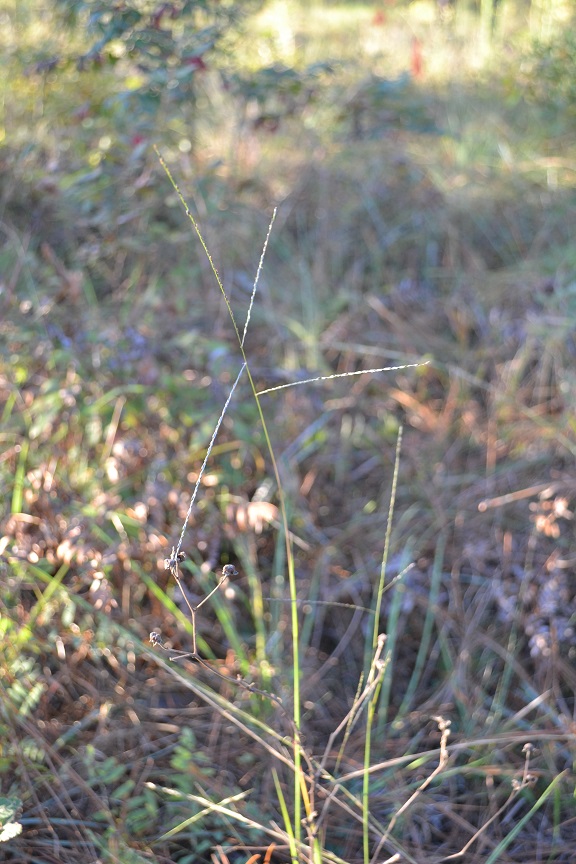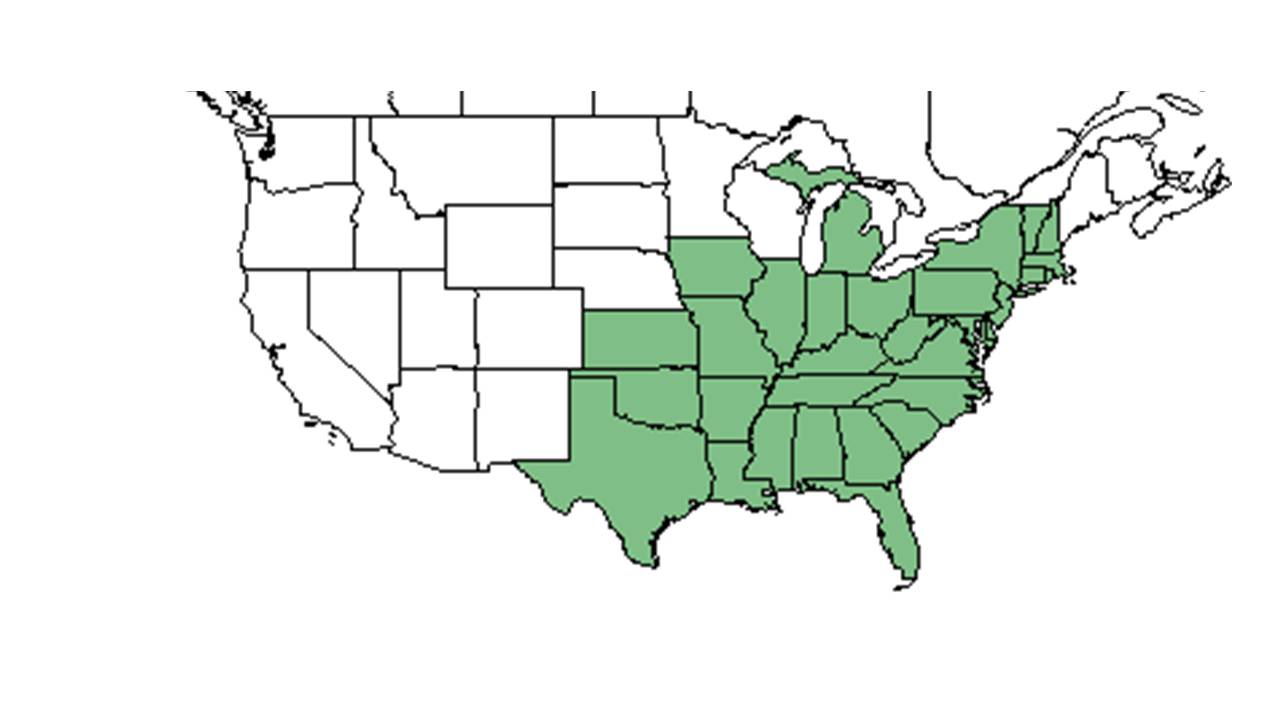Difference between revisions of "Digitaria filiformis"
| Line 39: | Line 39: | ||
===Phenology=== <!--Timing off flowering, fruiting, seed dispersal, and environmental triggers. Cite PanFlora website if appropriate: http://www.gilnelson.com/PanFlora/ --> | ===Phenology=== <!--Timing off flowering, fruiting, seed dispersal, and environmental triggers. Cite PanFlora website if appropriate: http://www.gilnelson.com/PanFlora/ --> | ||
Flowering and fruiting have been observed in June, August, September, October and November (FSU Herbarium). | Flowering and fruiting have been observed in June, August, September, October and November (FSU Herbarium). | ||
| + | ===Seed dispersal=== | ||
| + | According to Kay Kirkman, a plant ecologist, this species disperses by gravity. <ref name="KK"> Kay Kirkman, unpublished data, 2015. </ref> | ||
| + | <!--===Seed bank and germination===--> | ||
| − | |||
| − | |||
===Fire ecology=== <!--Fire tolerance, fire dependence, adaptive fire responses--> | ===Fire ecology=== <!--Fire tolerance, fire dependence, adaptive fire responses--> | ||
This species has been found in habitat types that are maintained by fire, which implies some level of fire tolerance (FSU Herbarium). | This species has been found in habitat types that are maintained by fire, which implies some level of fire tolerance (FSU Herbarium). | ||
Revision as of 14:55, 12 April 2016
| Digitaria filiformis | |
|---|---|

| |
| Photo taken by Kevin Robertson | |
| Scientific classification | |
| Kingdom: | Plantae |
| Division: | Magnoliophyta - Flowering plants |
| Class: | Liliopsida – Monocotyledons |
| Order: | Cyperales |
| Family: | Poaceae ⁄ Gramineae |
| Genus: | Digitaria |
| Species: | D. filiformis |
| Binomial name | |
| Digitaria filiformis (L.) Koeler | |

| |
| Natural range of Digitaria filiformis from USDA NRCS Plants Database. | |
Common name: slender crabgrass
Contents
Taxonomic notes
Synonym: Syntherisma filiformis (L.) Nash; Panicum filiforme L.
Description
Generally, for the Digitaria genus, they are "annuals; internodes glabrous. Leaves cauline; blade margins cartilaginous, scaberulous; sheath margins usually scarious; ligules membranous. Racemes racemose, ascending; rachis usually winged, scaberulous. Spikelets plano-convex, ellipsoid, acute. First glume usually absent, 2nd glume villous on nerves and margins, acute, sterile lemma 5-7 nerved, acute; fertile lemma and palea nerveless, cartilaginous, glabrous, acute; fertile lemma margins flat, hyaline. Grain whitish to brownish, ellipsoid. These plants are out worst field and gardens weeds." - Radford et al 1964.
Specifically, for D. filiformis species, they are "cespitose annual; culms 3-12 dm tall, nodes glabrous. Blades to 15 cm long, 2-4 mm wide, papillose-hirsute and scaberulous above, glabrous or occasionally pilose to hirsute beneath; sheaths papillose-hirsute; ligules erose to lacerate, 0.5-1 mm long. Racemes 2-7, ascending, 3-12 cm long; rachis trigonous, wingless, scaberulous. Spikelets 1.8-2.5 mm long; pedicels scaberulous, -.5-3 mm long. Second glume 5- nerved, 1.2-1.5 mm long, sterile lemma margins ciliate, 1.8-2 mm long; fertile lemma and palea purple, papillose lined, 1.8-2 mm long. Grain 1-1.2 mm long, whitish to brownish, ellipsoid." - Radford et al 1964.
Distribution
Ecology
Habitat
In the Coastal Plain region, Digitaria filiformis is found in pine-oak, oak-palmetto and open longleaf pine-wiregrass woodlands along with turkey-oak sand ridges, banks of ditches in saltmarshes, and transition zones between longleaf pine, turkey oak sand ridge and pine flatwoods (FSU Herbarium). Occasionally has been found in mesic flatwoods in Hillsborough County, Florida (Myers et al. 2003). It has been vouchered in an outcrop habitat on Panola Mountain located within Henry-Rockdale county line, southeast of Atlanta, Georgia (Bostick 1971). D.filiformis also occurs in the Kansas-Nebraska Drift Loess Hills characterized by divides with moderately steep slopes and silt loams and silty clay loam soils occasionally broken by bedrock outcrops (Watt et al. 1967).
Human impacted areas in the Coastal Plain region that have documented populations of D. filiformis include fallow and open weedy park fields, roadsides, powerline corridors, clobbered longleaf pine forest and cleared sand pine and pine flatwood communities (FSU Herbarium).
In the Coastal Plain region it has been documented as occurring on “upland, sandhill areas on droughty, infertile entisols and ultisols with loamy sand to sandy loam surface horizons” (Archer et al. 2007). It has also been recorded to occur in silty soils (FSU Herbarium). Light levels have observed to be partially shaded (FSU Herbarium).
Species found associated with D. filiformis in the Coastal Plain region are Liatris, Pityopsis, Aristida stricta, Aristida purpurascens, Andropogon gerardii, Pteridium aquilinum, Nolina atopocarpa, Hedeoma graveolens, Hedyotis procumbens, Angelica dentata, Rhynchospora globularis, Solidago and Eragrostis (FSU Herbarium).
Phenology
Flowering and fruiting have been observed in June, August, September, October and November (FSU Herbarium).
Seed dispersal
According to Kay Kirkman, a plant ecologist, this species disperses by gravity. [1]
Fire ecology
This species has been found in habitat types that are maintained by fire, which implies some level of fire tolerance (FSU Herbarium).
Use by animals
White-tailed deer stomach contents, in Kansas-Nebraska Drift Loess Hills, included Digitaria filiformis year-round (Watt et al. 1967).
Conservation and Management
Cultivation and restoration
Photo Gallery
References and notes
Archer, J. K., D. L. Miller, et al. (2007). "Changes in understory vegetation and soil characteristics following silvicultural activities in a southeastern mixed pine forest." Journal of the Torrey Botanical Society 134: 489-504.
Bostick, P. E. (1971). "Vascular Plants of Panola Mountian, Georgia " Castanea 46(3): 194-209.
Florida State University Robert K. Godfrey Herbarium database. URL: http://herbarium.bio.fsu.edu. Last accessed: June 2014. Collectors: Loran C. Anderson, H. E. Ahles, Tom Barnes, Michael B. Brooks, Robert W. Simons, Dianna Hall, R. Kral, R. K. Godfrey, Sidney McDaniel, R. A. Norris, H. R. Reed, Cecil R. Slaughter, Frankie Snow, A. E. Redford, C. Simon, A. A. Eaton, Robert L. Lazor, Bruce Hansen, JoAnn Hansen, W. A. Silveus, A. F. Clewell, Robert Blaisdell, O. Lakela, George R. Cooley, Richard J. Eaton, Daniel B. Ward, Paul O. Schallert, and A. H. Curtiss. States and Counties: Florida: Bay, Brevard, Clay, Dixie, Duval, Escambia, Franklin, Flagler, Gadsden, Hillsborough, Jackson, Jefferson, Leon, Levy, Liberty, Madison, Nassau, Osceola, Putnam, Sarasota, St. Johns, Taylor, Wakulla, and Washington. Georgia: Camden, Coffee, and Grady. Mississippi: Pearl River and Oktibbeha. North Carolina: Alexander. South Carolina: Hampton. Virginia: Pulaski. Other Countries: Switzerland.
Myers, J. H., and Richard P. Wunderlin (2003). "Vascular Flora of Little Manatee River State Park, Hillsborough County, Florida." Castanea 68(1): 56-74.
Radford, Albert E., Harry E. Ahles, and C. Ritchie Bell. Manual of the Vascular Flora of the Carolinas. 1964, 1968. The University of North Carolina Press. 138. Print.
Watt, P. G., G.L. Miller, and R.J. Robel (1967). "Food Habits of White-tailed Deer in Northeastern Kansas." Transactions of the Kansas Academy of Science 70(2): 223-240.
- ↑ Kay Kirkman, unpublished data, 2015.
